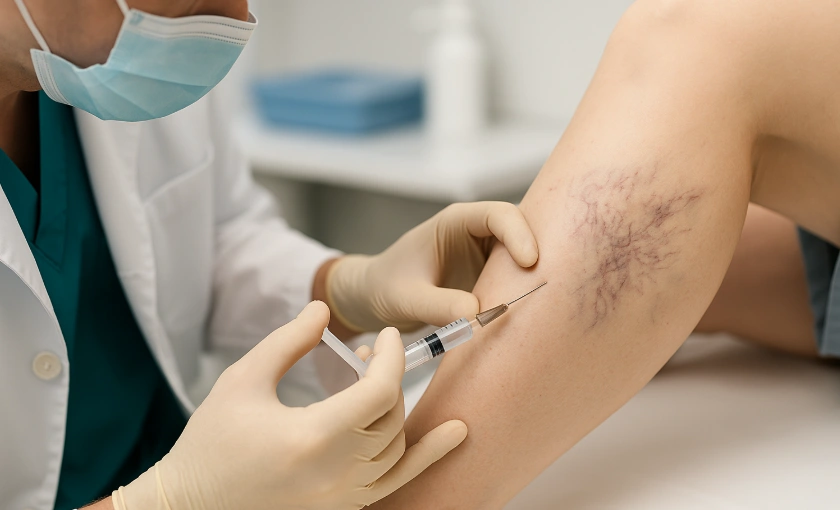Sclerotherapy: An Effective Treatment for Spider Veins and Smaller Varicose Veins

Sclerotherapy is one of the most trusted and commonly performed treatments for spider veins and small varicose veins. This minimally invasive procedure uses a specialized solution to collapse the diseased vein, allowing the body to naturally absorb it over time. The result is clearer, smoother skin and relief from symptoms such as swelling, itching, aching, or burning.
At BASS Vein Center, sclerotherapy is performed in-office by experienced vein specialists using advanced, evidence-based techniques. The treatment is quick, requires no anesthesia, and offers fast recovery with long-lasting results.
How Sclerotherapy Works
Sclerotherapy targets the inner lining of abnormal veins. During the procedure, your vein specialist injects a sclerosing solution—often polidocanol or sodium tetradecyl sulfate—into the affected vein using an extremely fine needle.
The solution causes the vein walls to stick together, blocking blood flow through the damaged vessel. Over the next several weeks, the treated vein closes completely and is gradually absorbed by the body. Blood reroutes through healthier veins, improving circulation and reducing the appearance of visible veins.
Most patients see noticeable improvement after one session, though multiple sessions may be recommended for larger clusters or stubborn veins.
Who Is a Good Candidate for Sclerotherapy?
Sclerotherapy is ideal for patients with:
- Spider veins
- Small varicose veins
- Discomfort such as itching, burning, or mild swelling
- Cosmetic concerns related to visible veins
Good candidates should be in overall good health and free from conditions that increase the risk of complications, including:
- Deep vein thrombosis (DVT)
- Current blood clotting disorders
- Active skin infections
- Pregnancy (treatment is typically postponed until after childbirth)
A consultation with a vein specialist is the best way to determine whether sclerotherapy or another treatment, such as EVLT, VenaSeal™, or radiofrequency ablation, is most appropriate.
What to Expect During the Procedure
Sclerotherapy is typically completed within 15 to 45 minutes, depending on the number of veins being treated.
Step-by-step overview:
- Your provider cleans and sterilizes the treatment area.
- A fine needle is used to inject the sclerosant into targeted veins.
- You may feel a mild tingling or slight burning, but discomfort is brief.
- After injections, compression stockings or wraps are placed to support healing.
- You can walk immediately afterward and resume normal activities the same day.
Most patients experience little downtime. However, strenuous exercise, saunas, and hot baths should be avoided for 48–72 hours.
Results: What You Can Expect After Sclerotherapy
Many patients notice vein fading within 3–6 weeks, with full results developing over several months. Larger veins may take longer to resolve or may require additional sessions.
Benefits include:
- Reduced appearance of spider veins
- Smoother, more even skin tone
- Relief from mild swelling, itching, or burning
- Improved leg comfort and circulation
Results are long-lasting, though new veins may develop over time due to genetics, hormonal changes, or venous insufficiency. Annual maintenance sessions can help keep legs looking clear.
Potential Side Effects and Risks
Sclerotherapy is considered extremely safe when performed by a qualified specialist.
Common temporary side effects include:
- Mild bruising
- Redness or swelling at injection sites
- Temporary itching
- Light brown discoloration (hyperpigmentation), which typically fades
Rare complications may include allergic reactions, blood clots, or skin ulceration.
Your provider will review your medical history to minimize risk.
Sclerotherapy Aftercare: How to Support Healing
Following your provider’s instructions is essential for optimal results. Post-treatment care may include:
- Wearing compression stockings for 1–2 weeks
- Avoiding hot tubs, hot baths, and saunas temporarily
- Walking daily to support circulation
- Avoiding prolonged sitting or standing
- Protecting legs from sun exposure for 2–4 weeks
Maintaining a healthy lifestyle—regular exercise, weight management, and hydration—can help prevent new veins from forming.
Get Expert Sclerotherapy Treatment at BASS Vein Center
If you’re ready to reduce the appearance of spider veins or small varicose veins, our board-certified vein specialists are here to help. We offer advanced diagnostics and the full spectrum of minimally invasive treatments in a comfortable office setting.
Schedule a consultation today by calling 925-477-3030.
Clearer, healthier-looking legs are just one appointment away.
Frequently Asked Questions
What is `?
Sclerotherapy is a minimally invasive procedure that uses a specialized solution to collapse and remove spider veins and small varicose veins.
How long does sclerotherapy take to work?
Most people see improvement in 3–6 weeks, though larger veins may require several months or multiple treatments.
Does sclerotherapy hurt?
Most patients feel only mild stinging or tingling during injections. Discomfort is brief and well tolerated.
How long is recovery after sclerotherapy?
You can resume normal activities the same day. Compression stockings are usually worn for 1–2 weeks.
Can spider veins come back after sclerotherapy?
The treated veins do not return, but new veins may form over time due to genetics or hormonal factors.
References
- Cleveland Clinic. Sclerotherapy. https://my.clevelandclinic.org/health/treatments/6763-sclerotherapy
- Mayo Clinic. Sclerotherapy. https://www.mayoclinic.org/tests-procedures/sclerotherapy/about/pac-20384592
- DermNet NZ. Sclerotherapy. https://dermnetnz.org/topics/sclerotherapy
- Journal of Vascular Surgery. Ultrasound- and fluoroscopy-guided foam sclerotherapy for lower extremity venous ulcers. https://www.jvsvenous.org/article/S2213-333X(19)30621-3/fulltext




